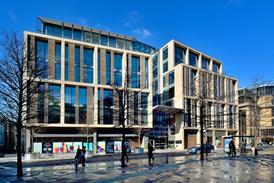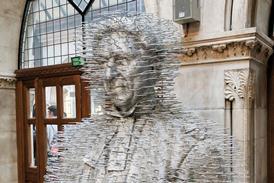Uxbridge magistrates’ court scored seven out of 35 in the Law Society’s latest report on court infrastructure, sitting with Manchester magistrates at the bottom of the table. Solicitors' comments about the court included ‘old’, ‘poor state of repair’ and ‘not conducive with the digital age’.
The Gazette decided to venture to west London to see for ourselves. Our courts editor reports:
On arrival, security was courteous - though I was asked for ID when I explained who I was. Some parts of the building seem, even to forgiving eyes, tired and temporary, with wall protectors and haphazard seating in the waiting room. But it is clean and seems to be functioning well enough. Spider plants beside the lists provide a splash of colour against the dominant grey and white.
The morning is a typical hive of activity. I was in the public gallery of courtroom 1 when a first appearance of a murder charge came up. It was automatically sent up to the Crown court. So far, so normal. Then a reporting restriction was imposed on naming the child who had been killed. Less normal.
Nobody objected, so I put my hand up to speak, cleared my throat but to no avail. I ran into the court well (the public gallery is behind a clear partition, effectively in a separate room) and explained what I assumed was basic rule: no reporting restrictions can be imposed on deceased children. The anonymity under s45 of the Youth Justice and Criminal Evidence Act 1999 was not correctly imposed and should be lifted.
Someone said: ‘I think she’s right.’
The magistrates were sent out. In their absence, we talked things over. The legal adviser was courteous and the defendant’s barrister agreed that a reporting restriction could not be imposed. When the magistrates re-entered, the chair thanked me. This is why local reporters are so important. It was chance that a journalist was there. Had there not been, the case would have moved to Crown with an incorrect reporting restriction in place. That could have caused delay and extra work to remove it when the press in the Crown court inevitably spotted the error.
Read more
Internet access, a point of issue in the court's poor rating, was fine for me, but I was there just for a day so maybe I was lucky. The plug sockets I did manage to find – a problem in most courts built before 2010, so I could write without worrying my laptop would die on me.
Courtroom 2 was dealing with a harassment trial. A much smaller room but comfortable enough. Courtroom 4 was different: a new carpet, no dock, and two skylights following the length of each side of the room. It was bright but although an odd configuration - I wondered where any public would sit - it worked well.
Overall verdict? A legal adviser who I spoke to was surprised to see that Uxbridge had scored so poorly. ‘I think we have a lovely court,’ she said.
It is true, the building is spacious and, though a little tired, seems to be functioning well. The toilets were clean and working, as was the lift. The temperature was bearable, and the screens in courtroom 4 played the necessary CCTV without any issue or slowdown in proceedings. One air conditioning vent in the waiting area between courtroom 1 and 2 had something hanging from it that did not look like it belonged, and the tiles around it were blackened with what I hoped was dust rather than mould.
Though some things were dated and may need a little modernisation, overall the state of Uxbridge magistrates' court did not seem a barrier to anyone: staff, lawyers and magistrates were working together like a well-oiled machine.
It might not be the most beautiful of machines, but in my opinion, Uxbridge does not deserve its dismal score.
We welcome suggestions of particularly terrible - or brilliant - courts for the Gazette to visit.
This article is now closed for comment.



























3 Readers' comments